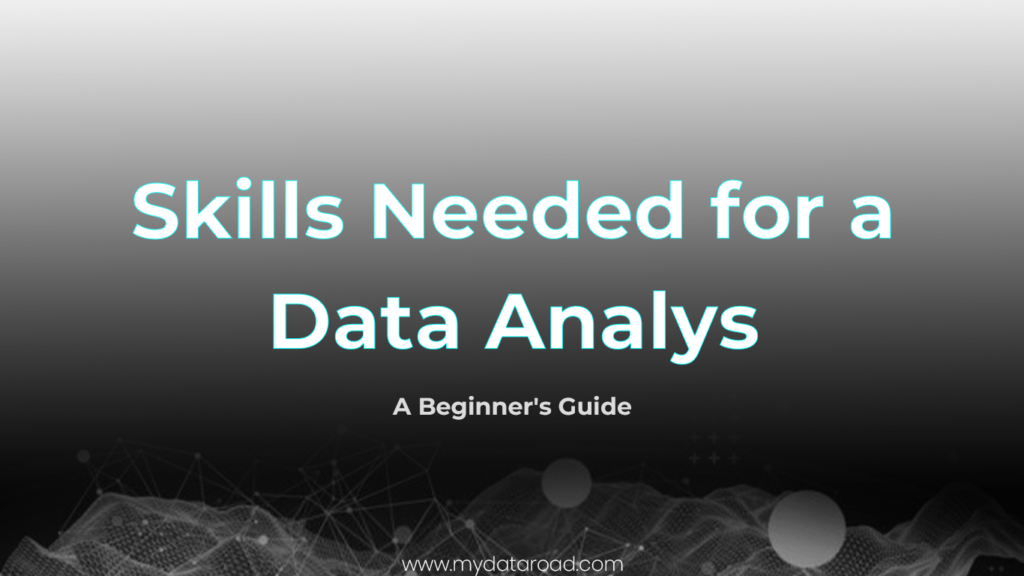As a beginner looking to start a career in data analysis, it’s understandable to feel overwhelmed by the breadth of skills required.
This guide will provide clarity on the essential technical and soft skills needed, with practical tips to help you prepare for data analyst roles or internships.
You’ll get a checklist of must-have qualifications, see real examples of using data skills in practice, and find resources to continue advancing your expertise over time.
Embarking on the Data Analyst Journey
This introduction will provide an overview of the key technical and soft skills required to become a proficient data analyst. It will summarize the main topics covered in the guide and set the stage for a deeper dive into the world of data analytics.
Exploring the Data Analyst Role and Responsibilities
Data analysts are responsible for collecting, cleaning, and organizing data to uncover insights. Common responsibilities include:
- Handling large datasets from various sources
- Using data modeling techniques to structure and format data
- Running queries in SQL to access and manipulate data from databases
- Performing exploratory data analysis with Python or R to surface trends and patterns
- Creating data visualizations and dashboards to communicate findings
- Making recommendations for operational improvements based on analytic conclusions
To succeed as a data analyst, core competencies include statistical analysis, data mining, data visualization, communication, and business acumen.
Preview of Data Analyst Skills Checklist
The key skills needed for a data analyst generally fall into two main categories:
Technical skills:
- SQL
- Python or R
- Statistical analysis
- Data visualization
- Machine learning
Soft skills:
- Communication
- Business acumen
- Creativity
- Critical thinking
This guide will provide a comprehensive skills checklist across these areas to set up aspiring analysts for career success.
Understanding Data Analysis Skills Meaning
Data analysis skills refer to the ability to collect, transform, and organize data to uncover actionable insights. Key competencies include working with large datasets, data modeling, statistical analysis, programming, data visualization, and communication skills to translate technical findings into business recommendations. Mastering data analysis skills is critical for extracting meaning from data and driving data-informed strategy and decisions.
What are the skills required for data analyst?
Data analysts need a diverse set of technical and soft skills to succeed in their roles. Here is an overview of some of the most important abilities for aspiring data analysts:
Technical Skills
- SQL: Structured Query Language is essential for extracting and manipulating data from databases. SQL skills allow analysts to efficiently organize, analyze, and present data.
- Statistical programming: Languages like R and Python are important for building statistical models and running data analysis. Analysts use them for tasks like regression, visualization, and machine learning.
- Machine learning: Understanding machine learning concepts lets analysts develop systems that can learn from data patterns and make predictions. This includes skills like training models, evaluating performance, and optimization.
- Probability and statistics: Having a solid grasp of statistical ideas like distributions, significance testing, and regression is key for data analysts. This helps them correctly interpret results.
- Data visualization: Creating effective charts, graphs, and dashboards to communicate insights is a crucial skill. Analysts need to visualize and present data in understandable ways.
Soft Skills
- Communication: Clearly explaining analytical findings to stakeholders is vital. Analysts need strong written and verbal communication abilities.
- Business acumen: Understanding business goals and metrics helps analysts focus their efforts. Domain knowledge improves their work’s impact.
- Creativity: Devising solutions for business challenges requires creativity. Analysts need to think innovatively with data.
Mastering these technical capabilities along with soft skills will prepare aspiring data analysts for career success. With expertise across these areas, analysts can extract meaningful insights to drive business value.
What qualifies you to be a data analyst?
While a bachelor’s degree is the most common entry-level qualification, some companies look for candidates with more advanced degrees like a master’s degree in data analytics or a related field. However, work experience and skills often matter more than formal education.
Here are the key qualifications to become a data analyst:
- Technical skills: Proficiency in SQL, Python, R, data visualization tools, statistical analysis, and machine learning is essential. Many job postings require knowledge of programming languages like Python and R, SQL querying, and data analysis software like Tableau.
- Analytical skills: Strong analytical abilities, like critical thinking, problem solving, attention to detail, and mathematical competence help make sense of data.
- Communication skills: Data analysts must present insights to stakeholders clearly. Strong written and verbal communication skills are vital.
- Business acumen: Understanding how businesses operate and how data analysis provides value aids in contextualizing and applying findings.
- Curiosity: Data analysts should constantly be curious about patterns in data and what questions the data can answer. An inquisitive mindset leads to impactful analysis.
While some advanced data analytics roles require a master’s degree, many entry-level data analyst jobs accept candidates with a bachelor’s degree coupled with strong data, analytical, and communication skills. Gaining work experience through internships also counts. Ultimately, the ability to derive meaningful insights from data is what qualifies someone to become a skilled data analyst.
Does data analyst require coding?
Yes, coding is an essential skill for data analysts. While you don’t need to be a software engineer, having basic proficiency in languages like SQL, R, and Python is extremely valuable.
Here’s a quick overview of some of the key coding skills data analysts should have:
- SQL: SQL is the fundamental language for working with databases and extracting data for analysis. You’ll need to be able to write
SELECTqueries to pull the data you need and perform tasks like joining tables, aggregating metrics, etc. - R or Python: These programming languages are very popular for statistical analysis and machine learning. You’ll use them for tasks like data wrangling, visualization, building models, etc. Python is more general purpose while R specializes in statistics.
- Basic scripting: Being able to write short scripts to automate repetitive tasks can save you a lot of time. Python and R allow scripting, but you may also use tools like Bash.
The good news is you don’t need to be an expert software developer. Focus first on getting comfortable with SQL and either R or Python at a basic level. Then you can continue to build upon those skills as you advance in your career. The key is being able to gather, prepare, analyze and interpret data programmatically.
So in summary – yes, expect to do some coding as a data analyst! But don’t let that scare you off. Start by getting the fundamentals down and build from there. The payoff of unlocking the insights hidden in data makes it very worthwhile.
What skills do data analysts need for life?
Data analysts need a robust set of technical and soft skills to succeed in their careers and everyday life. Here is a checklist of some of the most important skills a data analyst should develop:
Technical Skills
- Math and Statistics: Having a solid grasp of mathematical concepts like statistics, algebra, and calculus is essential for mastering data analytics. You’ll need to understand statistical analysis techniques to process, interpret, and derive insights from data.
- SQL: SQL skills allow analysts to efficiently query and manipulate databases, which store vast amounts of data. Practice writing SQL queries to select, filter, aggregate, join, and transform data.
- Data Visualization: Creating compelling data visualizations like charts, graphs, and dashboards makes data insights more consumable. Learn data visualization best practices and tools like Tableau, Power BI, or Python’s Matplotlib.
- Coding: While not strictly necessary, having coding skills in languages like Python and R helps analysts automate data tasks, implement machine learning models, etc.
Soft Skills
- Communication: Since analysts need to present data insights to stakeholders, strong written and verbal communication skills are a must. Tailor explanations to the audience’s technical level.
- Creativity: Thinking creatively helps analysts gain unique perspectives on data challenges. Brainstorm creative ways to manipulate, visualize or contextualize data.
- Business Acumen: Understanding business concepts helps analysts provide more impactful insights tied to core business goals. Continuously liaise with business teams to align efforts.
Mastering these technical and soft skills takes diligent practice but will serve any aspiring or current data analyst well in career and life. Let me know if you need any other tips!
sbb-itb-0c864d8
Analyst Technical Skills: The Data Analyst’s Toolbox
This section will provide details on key technical proficiencies needed for data analysis tasks, forming a comprehensive data analyst technical skills list.
Mastering SQL and Relational Databases
Using SQL to access, clean, transform, and organize data stored in relational databases is an essential skill for data analysts. SQL allows analysts to efficiently query large datasets in relational databases like MySQL, PostgreSQL, and Microsoft SQL Server. Key skills include:
- Writing
SELECTstatements to extract and filter data - Using
JOINs to connect data from multiple tables - Aggregating data with
COUNT,SUM,AVG, and other functions - Updating, inserting, and deleting data with
UPDATE,INSERT, andDELETE - Optimizing queries for performance
With SQL mastery, analysts can tap into the wealth of business data stored in databases to uncover insights.
Probability and Statistics: The Foundations of Data Analysis
Understanding probability and statistics fundamentally enables effective data analysis. Analysts rely on statistical concepts like distributions, significance testing, regression, and Bayesian statistics to derive meaning from datasets.
Key skills include:
- Calculating descriptive statistics like means, medians, and standard deviation
- Applying statistical testing to determine significance
- Building regression models to quantify relationships
- Understanding sampling distributions and confidence intervals
- Leveraging techniques like ANOVA, hypothesis testing, and maximum likelihood estimation
With a solid grasp of probability and stats, analysts can accurately model phenomena, forecast outcomes, and optimize decisions.
Data Visualization Techniques and Tools
Impactful data visualization is critical for digesting insights from data analysis. Data analysts need skills in:
- Data visualization best practices – visual encodings, layouts, explanatory text
- Creating charts and graphs like bar charts, line graphs, scatter plots, and heat maps
- Building interactive dashboards and reports with tools like Tableau, Power BI, and Google Data Studio
- Conveying concepts clearly to non-technical stakeholders
The right graphs and charts turn complex data findings into easily understandable formats for driving business decisions.
Data Modeling and Machine Learning Algorithms
While advanced, having exposure to data modeling and machine learning allows analysts to uncover deeper patterns and make predictions from data. Useful skills include:
- Techniques like classification, regression, clustering, recommendation engines
- Algorithms like random forests, KNN, SVM, neural networks
- Features engineering and data preprocessing best practices
- Model evaluation metrics – accuracy, AUC, RMSE, etc.
Machine learning takes data analysis to the next level for maximum business impact.
Utilizing Data Analysis Tools: From Python to Microsoft Excel
Data analysts use a wide range of tools, from Excel to Python:
Python offers advanced capabilities for statistical analysis, machine learning, and manipulating large datasets. Key functionality includes Pandas for dataframes, NumPy for numerical data, Matplotlib for visuals, and SciPy for technical computing.
Excel provides easy data cleaning, transformation, basic visualization, and analysis especially for smaller datasets. Important functionality includes formulas, pivot tables, conditional formatting, and chart creation.
Other Tools: SQL, PowerBI, Tableau, R, Apache Spark, database technologies like MongoDB and Cassandra, web scraping tools, and more.
By combining the right tools, data analysts obtain impactful findings and insights from data.
Core Data Skills Examples in Practice
This section covers practical applications and examples of data skills in real-world scenarios.
Case Study: SQL in Action
SQL is a crucial skill for data analysts to extract insights from large datasets. Here is an example of SQL in practice:
A retail chain needs to analyze sales data to optimize inventory and promotions. The data exists across multiple databases with 100+ tables. An analyst writes SQL queries to connect and aggregate this data into a single view for analysis. Key queries:
- Join sales, products, and store location tables to attach store IDs and product details to each transaction.
- Write conditional logic in WHERE clauses to filter data by date range, product type, store region etc.
- Use SQL functions like AVG() and SUM() to calculate total revenue per product per store.
- Create temporary tables and views to simplify complex logic into reusable code.
This allows the analyst to build a full picture of sales data and identify top-selling products by region over the past year. The insights help determine optimal inventory levels and localized promotions.
Applying Probability and Statistics to Market Analysis
Statistical methods help analysts quantify trends and predict outcomes. For example, a startup wants to launch a new product. The analyst gathers data on:
- Demographic info of target customers
- Sales data of similar products
- Market size and growth projections
They use statistical analysis to:
- Calculate confidence intervals to quantify market uncertainty
- Run regression analysis to identify factors driving product adoption
- Forecast sales trajectories using time series analysis
This quantifies the startup’s market opportunity and clarifies key variables that influence product success. Management uses these data-driven insights to inform launch and growth strategies.
Visualizing Success: Effective Data Presentation
Data visualization is crucial for conveying insights to stakeholders. For example, a hospital wants to reduce patient readmission rates. The analyst visualizes factors driving readmissions:
This interactive dashboard allows executives to filter by patient attributes and admission details. Key visualizations:
- Choropleth map shows readmission rates by geographic area
- Scatterplots reveal correlations between age, condition severity and likelihood of readmission
- Line chart displays monthly readmission trends
The intuitive data presentation provided actionable insights that helped hospital leadership target initiatives to successfully lower readmissions by 15% year-over-year.
Machine Learning for Predictive Insights
Machine learning empowers analysts to uncover insights from complex data. For example, a bank wants to improve lending decisions. The analyst builds a loan default prediction model using:
- Historical applicant data
- Bureau credit scores
- Macroeconomic indicators
They train gradient boosting machine and random forest models. Key techniques:
- Cross-validation to tune model hyperparameters
- SHAP values to determine feature importance
- SMOTE oversampling to handle class imbalance
The final model achieves 85% AUC-ROC accuracy. By integrating these predictive insights into lending decisions, the bank reduced defaults by 30% while still lending to creditworthy applicants.
Soft Skills for Data Analysts: Enhancing Technical Expertise
This section highlights critical thinking, communication, and other soft skills that complement technical abilities and are essential for a data analyst’s success.
Communication and Storytelling with Data
As a data analyst, clearly communicating insights from data analysis to non-technical stakeholders is a critical skill. Mastering data storytelling allows analysts to compellingly convey key findings, trends, and recommendations to drive business decisions.
Here are some tips to improve communication and storytelling as a data analyst:
- Simplify complex concepts using clear language, meaningful analogies and visualizations
- Focus on the key takeaways instead of getting lost in granular details
- Structure narratives logically to build towards core conclusions
- Emphasize impact on business goals to capture stakeholder attention
- Customize explanations based on the audience’s background and interests
Sharpening communication skills takes practice, but is essential for making an impact as a data analyst.
Critical Thinking in Data Interpretation
Strong critical thinking abilities help data analysts derive meaningful insights from data. Key aspects include:
- Asking incisive questions to deeply understand the problem context
- Identifying assumptions that may influence analysis
- Evaluating data relevance by linking back to original goals
- Considering alternative hypotheses instead of jumping to conclusions
- Validating analysis with statistical testing to avoid bias
Applying critical thinking at each stage of data analysis reduces errors and drives robust, logically-sound conclusions.
Creativity in Problem Solving: A Data Analyst’s Perspective
While data analysis relies heavily on technical skills, creativity enables analysts to:
- Frame problems differently to uncover innovative solutions
- Think expansively to identify useful data sources
- Visualize data patterns in insightful new ways
- Question traditional assumptions that limit analysis
Creative problem solving expands the solution space and allows analysts to tackle challenges from new angles.
Collaboration and Teamwork in Data Projects
Data analysts rarely work in isolation. Collaborating with diverse teams enables analysts to:
- Draw on specialized expertise across business functions
- Incorporate different perspectives for richer insights
- Break down data silos by sharing information
- Align analysis to broader organizational goals
Effective collaboration allows analysts to produce higher-impact work. Key skills include communication, empathy, flexibility and recognizing team members’ strengths.
Preparing for a Data Analyst Internship: A Skills Guide
Internship Readiness: Technical Skillset Overview
As an aspiring data analyst, having a strong grasp of key technical skills will make you a competitive candidate for internship opportunities. Here are some of the core competencies you should focus on developing:
- SQL – Learn basic and advanced SQL queries for accessing and manipulating relational databases. Being able to extract insights from raw data is critical.
- Python or R – Proficiency in Python or R programming is expected for handling data analysis and visualization. Concentrate on one over the other based on personal preference.
- Statistics – Build a working knowledge of statistical concepts like distributions, significance testing, regression models, etc. This strengthens quantitative analysis abilities.
- Data Visualization – Creating visualizations like charts, graphs, and dashboards to derive meaning from data is an indispensable skill. Master Excel and explore tools like Tableau.
- Machine Learning – Gain exposure to machine learning algorithms and their real-world application through online courses or hands-on projects. This demonstrates interest in leveraging AI.
Check out analyst job descriptions and tailor your skillset to use the right tools for tasks you’ll be handling as an intern.
Soft Skills Development for Aspiring Interns
While technical aptitude is important, data analytics interns also require certain soft skills to thrive in workplace settings:
- Communication – Convey analysis insights clearly to non-technical colleagues through presentations, reports, or discussions.
- Collaboration – Cooperate across teams and with stakeholders to understand data needs and deliver solutions.
- Creativity – Think innovatively when approaching problems and visualizing data to reveal key trends.
- Time Management – Handle multiple priorities and projects while meeting tight deadlines.
- Adaptability – Adjust to rapidly evolving technologies, data sources, and business requirements.
Develop these abilities through group projects, community engagement, and professional networking.
From Classroom to Boardroom: Bridging the Gap
Transitioning from an academic environment to a professional one as an intern can be challenging. Here are some tips:
- Apply concepts – Identify opportunities to practice what you’ve learned in real workplace contexts instead of theoretical examples.
- Ask questions – Don’t hesitate to ask colleagues for explanations, best practices, or their own career advice.
- Familiarize with tools – Get hands-on experience using the specific data analytics programs and systems used at the company.
- Understand business goals – Align your analysis and reporting with broader organizational objectives and strategies.
- Network – Attend meetings, social events, and industry conferences to expand your connections.
Being proactive will help you get the most out of an internship.
Finding the Right Internship: Aligning Skills with Opportunities
Look for internships that match your existing proficiency but also allow you to expand your capabilities. Avoid roles with tasks completely outside your wheelhouse.
- Audit your skills, then review internship descriptions and required qualifications.
- Prioritize opportunities at data-driven companies you’re interested in.
- Weigh small vs. large organizations based on learning preferences.
- If lacking key skills, take online courses to boost your profile.
- Reach out to alumni at target companies for referrals.
Securing the right internship accelerates your path to becoming an analytics professional.
Building a Data Analysis Toolkit: Practical Resources and Tips
This section provides tips on developing a practical toolkit with reusable frameworks, templates, code snippets, etc., for efficient data analysis.
Creating a Reusable Analysis Framework
Having a standardized analysis framework ensures consistency across projects and allows you to reuse code instead of reinventing the wheel. Here are some tips:
- Build templates for common workflows like data cleaning, EDA, modeling, etc.
- Parameterize key parts to make frameworks adaptable.
- Store frameworks under version control for easy access and updating.
- Annotate steps thoroughly for future reference.
- Over time these become your “go-to” recipes for analysis.
Building a Library of Code Snippets for Efficiency
Curate a library of handy code snippets in Python/R for regular data tasks:
- Save snippets every time you solve a new problem.
- Organize by analysis stage and languages.
- Include datasets in case the code relies on certain data structures.
- Share libraries across teams to promote collaboration.
- Over time these become building blocks that speed up your workflow.
Utilizing Interactive Notebooks for Learning and Collaboration
Interactive notebooks like Jupyter integrate code, visualizations, and text annotations. Benefits:
- Create tutorials for yourself documenting data analysis workflows from end-to-end.
- Annotate key parts of the code to explain each step.
- Visualizations illustrate the output after major stages.
- Share notebooks with colleagues for review and feedback.
Leveraging Open-Source Tools for Data Analysis
Many high quality open-source libraries exist for data analysis:
- Scikit-Learn, Pandas, NumPy for machine learning in Python.
- Tidyverse for data wrangling in R.
- D3.js for interactive browser-based visualizations.
- Leverage these free resources before paying for proprietary software.
- Stay active in their open-source communities.
Over time, assembling these reusable components pays dividends when conducting analyses more efficiently. The key is being disciplined about documenting solutions for later reuse.
Continuous Learning: Advancing Your Data Analysis Skills
As a data analyst, continuously improving your skills is crucial for career growth and staying current with the latest advancements in the field. Here are some recommendations for advancing your data analysis capabilities:
Online Courses and Certifications for Analyst Technical Skills
Structured online courses and certifications from platforms like Coursera, Udemy, and edX can help analysts strengthen core technical competencies:
- SQL, Python, R certification programs
- Machine learning and AI specializations
- Statistics and predictive modeling courses
- Big data and cloud analytics training
Leveraging such technical coursework allows analysts to systematically build expertise.
Engaging with Blogs and Podcasts for Industry Insights
Industry blogs and podcasts provide valuable perspectives into data analysis best practices:
- Subscribe to thought leaders and experts for insights
- Learn new techniques and approaches for analysis
- Understand developments in AI/ML space
Actively engaging with such content shares knowledge that can be applied.
Networking at Conferences and Meetups
Attending in-person and virtual data analytics events enables valuable networking and skill-sharing:
- Connect with peers and mentors
- Discuss challenges and innovations
- Explore job opportunities
Conferences and meetups facilitate peer learning essential for growth.
The Importance of Peer Review and Feedback
Collaborative peer review of analysis and projects accelerates competency:
- Welcome objective assessments from colleagues
- Identify gaps and areas needing improvement
- Iterate approaches based on insights
Embracing feedback is key for refinement.
Continuous skills advancement is key for data analysts to remain competitive and maximize their potential. Using the strategies outlined can help analysts achieve enduring career success.
Related posts
- Skills Needed to Become a Data Analyst: A Primer
- Skills Needed for Data Analyst: Core Competencies
- Skills Required to Become a Data Analyst: Your Ultimate Guide
- Skills to Learn for Data Analyst: A Comprehensive Guide

Tech Writer | Data Analyst | Digital Creator



